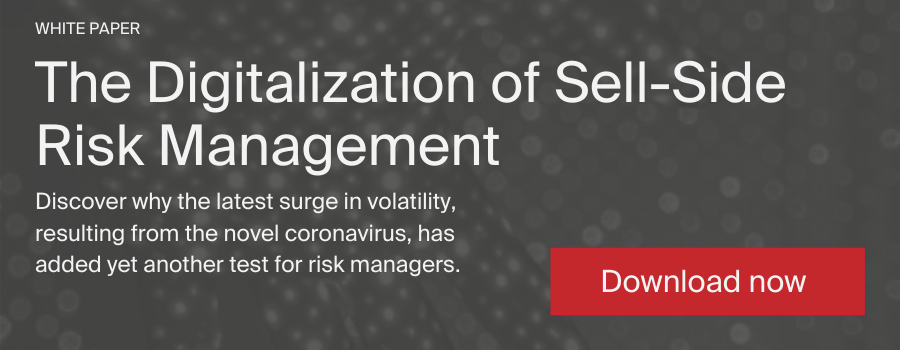Trading banks must as a minimum implement the “standardised approach” to comply with the new Fundamental Review of the Trading Book (FRTB) set of regulatory proposals. In this article we look at how advanced analytics tools can help banks derive insights beyond minimum FRTB compliance.
Beyond spreadsheets
The spirit of the regulation is to improve capital adequacy, but banks can derive many additional benefits if the implementation of FRTB has a strategic vision. While it’s possible to implement the required calculations for the standardised approach in spreadsheets – and this will produce a capital charge number to keep regulators happy – it doesn’t easily allow banks to leverage these calculations in other ways. A well-designed system will provide robust, repeatable calculations and have the flexibility to support advanced analytics to offer insights into the capital charge.
What are the drivers of your FRTB capital charge?
Understanding what drives your capital charge is crucial but it isn’t straightforward. Even if a trader knows all their positions by heart, the prescribed bucketing and aggregation makes it very hard to intuitively understand the attribution of the capital charge. Seeing the marginal impact of removing a position or risk factor can provide valuable insights about the contributors to the top level figure.
Incremental changes can produce “capital greeks” to help understand the effect of single risk factors or groups of factors, such as all points on an interest rate curve or options with a given maturity.
Scenarios and pre-deal checks
Once you’ve understood the breakdown of your capital charge, the next key insight is how your capital charge might change based on adding or removing trades. This is useful for risk managers looking to experiment with different hedging strategies or see the effect of desks moving between SA and IMA, as well as traders who need to know the capital impact of a trade before it’s executed; this may feed into the pricing of the trade or even its viability.
These “pre-deal checks” are not possible without carrying out a full recalculation of the capital charge, to take into account the new position’s interactions with the existing portfolio. Advanced analytics automate this process for banks, which helps the trader’s decision-making process.
Find out about Percentile's FRTB solutions
How advanced analytics assist stress testing
Stress testing allows you to assess the impact of changes to input data on your capital charge, outside of (or in combination with) changing the makeup of the portfolio. Many of the inputs are prescribed (such as weights and correlations) or effectively constant over time, so the scope for stress testing is limited: there’s little point in assessing the impact of Apple jumping sectors or becoming a small, emerging economy stock.
A key capital driver that can change is credit quality, which affects both the sensitivities-based method and default risk charge. Stress tests that drop the credit rating for a single issuer or groups of issuers within regions or sectors can give valuable insights into the impact of potential coordinated changes in creditworthiness.
Sensitivities can also vary over time, and may display particularly large changes approaching maturity. A simulation that shocks sensitivities in this way can highlight potential problems in good time so they can be addressed.
Reducing the capital charge
Reducing your capital charge involves reducing the three components of the standardised approach:
(1) the Sensitivities-based Method (SbM)
The SbM is a process of aggregation that combines sensitivities at the level of risk factors, with sensitivities to any given risk factor offsetting across positions. The intricate bucketing, correlations and aggregation make it hard to see the impact that changing a risk factor has on the top level capital charge figure.
Each risk factor is placed in a bucket, and within each risk factor bucket there are correlations defined by the regulator. There are further prescribed correlations between these buckets to aggregate to a risk class, eg Interest Rate or Equity. On top of this, the charges are calculated as the maximum across three different correlation scenarios, which adjust the correlations to different degrees; the chosen scenario may change as the hedging profile of the portfolio changes.
An effective analytics tool will identify risk factors and combinations of factors that contribute the most to the capital charge and can suggest long/short sensitivities that will offset them. With more sophistication, it can suggest offsetting trades, taking into account that risk factors can rarely be hedged in isolation.
(2) Default Risk (DRC)
The default risk charge consists of an aggregation of risk-weighted short and long jump-to-default (JTD) values at the issuer or tranche level, which are then allocated to buckets. The buckets are combined with a simple sum, but within a bucket the calculation is complex, taking into account the relative seniority and maturity to determine offsetting of long and short exposures.
Analytics will identify the JTD values with the greatest impact and can suggest suitable hedging strategies, pinpointing the maturity and seniority of credit products required to effectively offset issuer exposure.
(3) Residual Risk (RRAO)
There is no complex interaction in the calculation of residual risk. It is just a percentage of the absolute notional. The only way to reduce it is by reducing your notional.
Why data quality is critical, and how bad data increases the capital charge
The data that feeds into the capital charge calculation, including metadata and company profile data, must be accurate. For instance, if you are missing certain reference data in your input, such as the company sector, it will be included in a separate bucket, which can be punitive for the capital calculation and increase it considerably.
Advanced analytics can assess the impact that bad or missing data has on the capital charge. It highlights where there are problems with data quality and can associate a cost, in terms of increased capital, with a missing industry sector or credit rating.
The final word on advanced analytics and FRTB compliance
Satisfying regulatory obligations is the minimum requirement for banks. However, there is so much more that banks can do by going beyond the calculations and implementing advanced analytics. A bank equipped with an advanced analytics tool can execute the standardised approach more easily and conveniently, and it receives a rich stream of actionable business insights.





